The turbulence jolts me from my sleep as our captain manages a hurried announcement, “The seatbelt sign has been turned on; please remain seated for the remainder of the flight.” Struggling through the edgy chaos of unstable atmosphere, I feel the cabin pitch into a not so subtle descent and slide open the window shade in my jet-lagged haze to find a vast, rocky, moon-like landscape below set against a backdrop of jagged, icy peaks, framed by the Andes mountains towering into the sky forming the horizon. Whose idea was this anyways? As North Kiteboarding employees and team riders, we all live in balmy, beautifully scenic places””the perfect (read convenient and warm) locales for a product shoot. My ideas about what’s important in getting the ideal kite shot revolves around convenience, but instead we had a 20-hour flight, logistical baggage gauntlets and duffle bags full with the necessary neoprene. My seatback tray nearly stows itself in a violent drop that seemed capable of unseating every bolt in our airbus, and it occurs to me that I don’t really know much about our South American destination apart from some pictures I’d seen in National Geographic; a piece selling Patagonia’s cold and unforgiving environs, its rugged terrain and a vast open wilderness filled with glaciers and wild animals. Don’t get me wrong. When I got the invite to Patagonia to ride along on a photoshoot I was drawn to what seemed like a once in a lifetime experience, however, I always imagined myself in Patagonia for the purpose of ice climbing, fly-fishing or trekking through the mountains””not kiteboarding. As the wheels touched down and the plane came to a stop at the terminal, the other passengers began gathering their Patagonia packs and Columbia thermal jackets from the overhead compartments and I couldn’t help think how atypical of a kiteboarding destination this was. This was also the moment I realized my two pairs of jeans and the couple of hoodies I’d hastily thrown into my suitcase back home in Hawaii would pose a very real and substantial logistical problem once on the ground: staying warm. I wandered out of the tiny terminal into a brisk 30-knot breeze. As the cold, dry mountain air hit me, it immediately confirmed my suspicion that I had definitely underpacked for Patagonia’s weather. Since I was the only one dragging a board bag, our guide, Rafael, had no trouble spotting me. After a brief introduction, we were on our way to meet the rest of our crew: Brazilian freestyle maestro Reno Romeu, New Caledonian wild-man Tom Hebert, our team manager Tommy and our film crew (whose sole purpose was to torture the talent with endless takes and retakes and therefore shall remain anonymous). I mentioned to Rafael that it seemed pretty windy. “Don’t worry,” he nonchalantly replied despite today’s brisk wind that had made landing such a pleasure, “Tomorrow it should be picking up.” The glacial assault team, (L to R) Hawaiian transplant Sky Solbach, Brazilian Reno Romeu and the affable New Caledonian Tom Hebert. A short drive in Rafael’s truck and we arrived in the town of El Calafate. Consisting of a single main street with multiple hotels, restaurants and cafes, it’s a popular stopover for backpackers and trekkers who are here to see the glaciers, mountains and beautiful scenery that make Patagonia famous. Rafael and I found the rest of our crew sitting down to a steak lunch at a small restaurant and I soon came to realize that every meal in Argentina consists of steak in one form or another””a vegetarian’s nightmare. The next day Rafael took us to a local flat-water spot on the outskirts of town. “This spot is amazing. Best place in Calafate,” he tells us. The water is indeed super flat and the wind is blasting over a small island creating butter-smooth water on the lee side. The spot is great; it’s got a sandy launching area, a seeming rarity in this rugged terrain, except there’s just one problem: There are no mountains and no backdrop, just low-lying A-frame houses and apartment buildings sprawled over a barren hillside. Tommy, the most responsible company representative on the trip, gave me one look that said, “We didn’t travel all this way to get kiting shots with houses in the background.” This spot could literally be anywhere””we needed mountains, snow and some icebergs. We needed the icons of wild country, we needed a backdrop that screamed Patagonia””not a freestyle slick that had the unfortunate scenic value of a laconic suburb. I took Rafael aside and pointed to the jagged mountains in the distance and asked if he knew of any other spots that would allow us to kite in front of peaks. And so began the established theme of our trip: aimlessly searching for scenic shooting locations. The first spot check was a perfect flat-water slick with the photogenic values of a Denver suburb. After a short debate, Rafa as we would begin calling him, told us of a spot ”˜just around the corner.’ We collected Tom, Reno and the film crew and set off down an endless dirt track. After a bouncy off-road ride, the truck rounded a corner and we grasped our first view of a massive glacier-fed lake””the stunning sight we had envisioned. Amped to boost some airs in the steadily increasing 35-plus knot breeze, we awkwardly fumbled into our 6mm wetsuits, gloves, booties and hoods. With nothing in the way of a launch spot, we cheated death while scrambling over slippery rocks in a hasty urge to devour our first taste of Patagonia kiting. The cold air packed a serious punch; the water was like a biting animal that never let go and 35 knots in South America seemed significantly stronger and more powerful than the warm trades of Hawaii. Surrounded by the surreal, we boosted board-offs, one-footers and big lofty jumps until our faces and fingertips went totally numb. After this first session, our perception of cold water kiting had been altered; I was struck with how quickly a remote and fantastically raw region can help you forget six millimeters of rubber and at that point we knew we were in for an epic couple of weeks. The following morning we drove several hours on dirt tracks to reach a remote kite spot on one of the many glacial lakes in the area. Rafa had arranged permission for us to cross through thousands of acres of private ranch land to reach our destination. It became a game for who’d open and close the sheep gates as we made our The debris, swirling wind and water currents moving around the massive ice field creates a series of unknown hazards beyond the obvious risks of hypothermia. With no internet connection, no television and not another soul around for miles, we spent the next several days kiting in front of our campsite, exploring the surrounding area on foot and gathering wood for evening campfires. On one of our lay days we took Rafa’s small safety boat out onto the lake to check out a massive chunk of ice that had shelved off the glacier and floated with the wind closer to our base camp. From a distance, the iceberg looked like a big floating ice cube and for some childish reason, I imagined it would be covered in something soft and snow-like. Pulling up next to it, Reno, Tom Hebert and I quickly scrambled out of the boat and onto the floating iceberg. We were blown away by how thick and solid the thing was; there was nothing soft about it. Standing You can look but you cannot touch””as Sky and the team would soon learn, playing around glaciers is no laughing matter. As the trip wore on we scored some decent sessions at the campsite but the wind direction prevented us from venturing nearer the glacier. We could see and hear it in the distance, as if it were taunting us and our mission, but we knew there was just no way to get close to the glacier without the wind changing to a more favorable wind Rafa said he knew another good spot ”˜just a few hours away’ that could offer some pretty epic photo conditions and we opted into what we thought would be a little road trip across the border to Chile. Perhaps lost in translation, ”˜just a few hours away’ had us driving for days””first to reach the National Park of Torres Del Paine and then all the way through its vast wilderness. This national park is considered one of the most pristine and beautiful in all of Patagonia. The mountain peaks and endless lakes are untouched and the sheer size and scope of the topography is jaw dropping. Massive condors circled overhead as wild foxes, armadillos, llamas and rhea frolicked in the fields. We found some epic setups for kiting but they were all off-limits and required special permission from landowners and park rangers. One farmer asked us for a one-time fee of $5000 to kite for one hour on his lake””an offer which we had Rafa politely decline. We learned that the habitat here is so fragile that simply introducing bacteria from one lake to the next could have devastating environmental consequences so we took in the scenery, but did not have the option to kite. We can look but we can’t touch. After putting several thousand kilometers behind us on our search for good kite conditions in Chile, we were itching to get back to Argentina to take one more stab at reaching the massive glacier by kite. It was a seemingly simple goal yet every attempt so far has been thwarted. Rafa insisted the forecast was lining up for a promising Sky setting up his Nugget with the looming glacier in the far distance; little did he know of the challenges inherent in glacial kiteboarding. After days on the road, we finally returned to our original campsite with our glacier gleaming under the moonlight. When we awoke the following morning the window of opportunity seemed upon us with the wind models putting the glacier within reach. We loaded our kite gear into Rafa’s boat and motored for nearly two hours, battling fierce chop and a piercing 30-knot headwind to the first stop on our approach to the glacier””a monumental journey none of us could have anticipated. With our boat beached within a small cove two miles from the glacier, we packed our gear and hiked over a headland and into a forest. Finally breaking clear of the trees, we found ourselves standing one mile from the glacier, our monument in all of its glory. With the wind looking solid we hastily climbed into our full wetsuits and scrambled to inflate kites. After multiple thwarted attempts, the drive and walk option seemed to be the best approach to an otherwise unobtainable glacier. Just as soon as Hebert had his kite in the sky, the texture on the lake cycled through and the lake reverted to a sheet of glass. We waited. First 15 minutes, then a half hour, then an hour. It doesn’t seem to be turning back on. We fear we’ve missed our only opportunity to explore this massive glacier. While corporate wanted their product shots, we desperately wanted the experience. We had logged hours by car, by boat and on foot and just as Aptly labeled ”˜the money shot,’ Sky, Reno and Tom finally get themselves within shooting distance of the towering wall””the true epitome of adventure kiteboarding travel. Trading tacks while trying to remember the photographer’s directions, we kept hearing massive chunks break free, slamming into the water. Despite this shedding goliath being several hundred feet away, we would cheer and scream at the top of our lungs as the power and energy of a 10-ton chunk of ice detonated on the surface of the frigid water””the displaced energy surging under our boards was both surreal and shocking. While kiting in formation for glossy product brochures is anything but inspiring, we got the shot we came for and what’s more, in that aim we stumbled our way through one of the best kiteboarding trips of our North careers. Sitting around the campfire later that evening and reflecting on the events of the day, we reminisced on the meaning of being totally at one with our surroundings, while being brought to acknowledge our insignificance in the face of such an extraordinary presence of Mother Nature. As individuals and as a brand we are often seeking locations with the perfect wave or the flattest water, but in Patagonia we got off the well-beaten path and captured a different This article was first featured in Tkb’s summer 2017 issue, Vol. 14, No. 2. Want more like this? Subscribe here: https://www.thekiteboarder.com/product/magazine-subscription/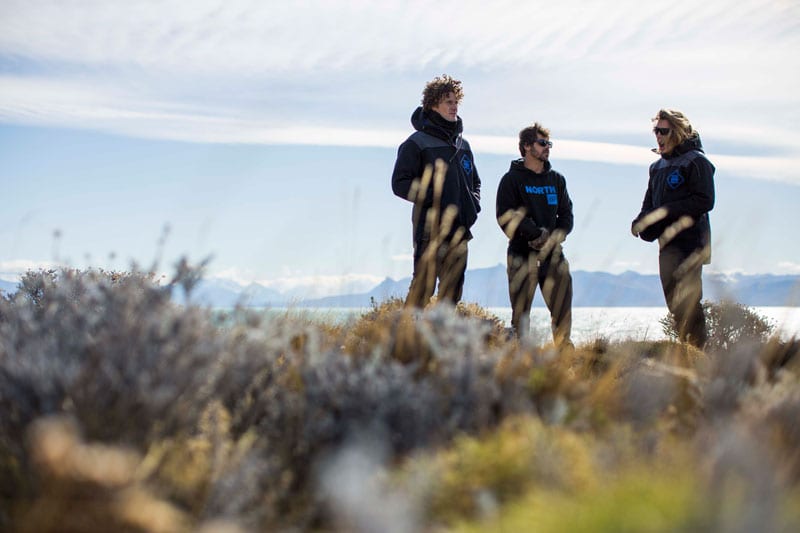
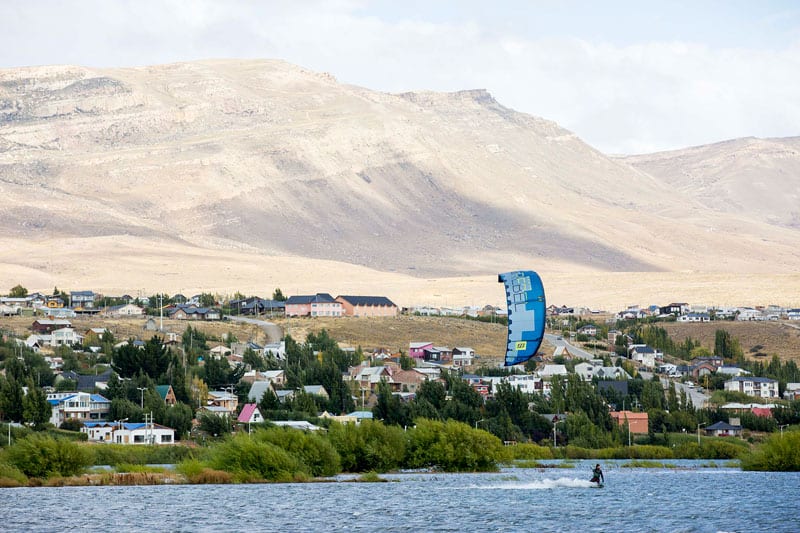
way through grassy lands surrounded by snowcapped peaks in every direction. Reaching our destination by late afternoon, we set up camp on the shores of a massive lake with one of the largest glaciers in Patagonia looming in the distance. About 20 miles upwind of our camp, it was difficult to capture a mental grasp on the size of the
massive chunk of ice looming in the distance. Rising directly out of the lake, we were told the sheer ice wall was over 250 feet tall. From our distance we could hear the constant cracking of the ice, like distant thunder or the piercing creak of splitting wood from the mammoth’s slow movement. We watched as chunks shelved off to the water below, sending out surges of frothy whitewater upon impact. Our stomachs tied into knots as we imagined the prospect of kiting in front of this incredible force of nature””we could only hope that conditions would align so we could get close, allowing us a glacial approach under the power of our kites.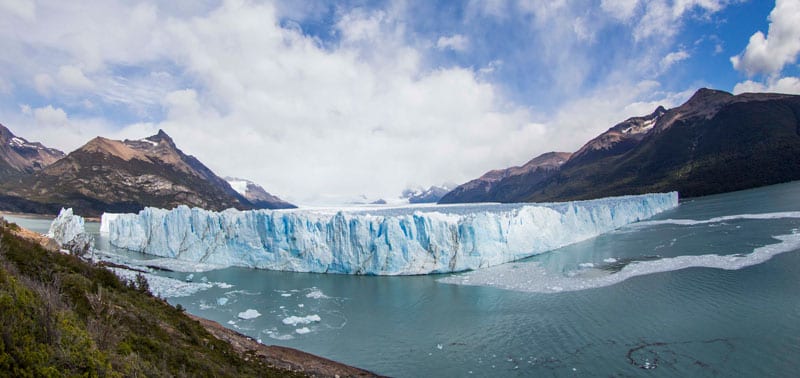
upon the floating glacier offshoot, the iceberg was like a big, slippery piece of floating concrete; we marveled at how easily one of these things took down the Titanic. As we stood atop the giant piece of ice, I mentioned to the guys that I thought the iceberg seemed to be shifting a bit. “Nah”, said Tom. “No way. It’s too big to move.” Thirty seconds later I see the horizon start to shift and Tom and Reno scramble to the edge of the iceberg before plunging 15 feet down to the icy water below. I’m not far behind, but the slow roll of this giant mass steamrolled into a rather deliberate and aweinspiring capsize. My last step, an attempt at a gigantic leap was in all actuality a clumsy slippery stumble rather than a solid head start. My trajectory was far less than ideal under the rather serious situation. After recovering from my water flop and resurfacing with the rotating hulk to my back, I struggled with a few panicked strokes to earn some distance. Before I could even look over my shoulder the iceberg had completed a 180 degree roll with waves pushing me clear. We hauled ourselves back onto the safety of Rafa’s boat and simultaneously broke into hysterics. High fives abounded amid revolving bouts of uncontrolled laughter followed by weighted ”˜what ifs’ that made it clear we all knew that stunt could have easily gone horribly wrong. We chalked it up as a lesson learned: Don’t play on icebergs.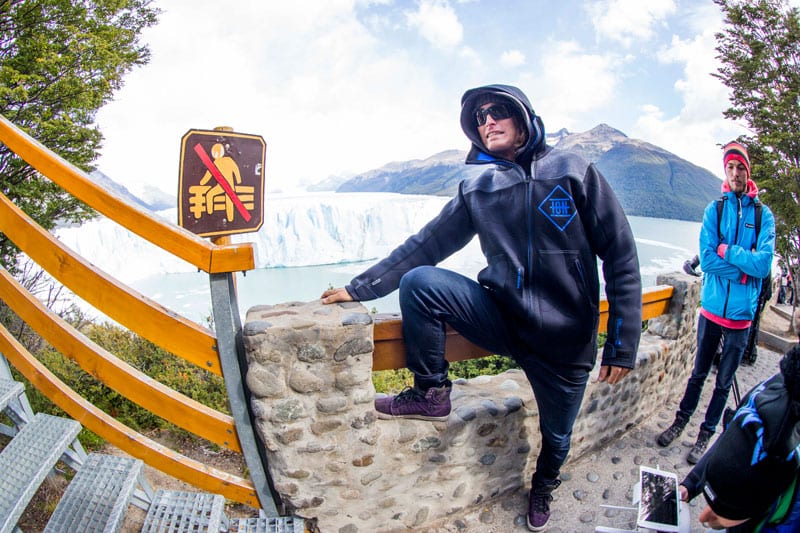
direction.
setup but the sheer distance we had ventured was threatening to ruin our chances of making it back in time.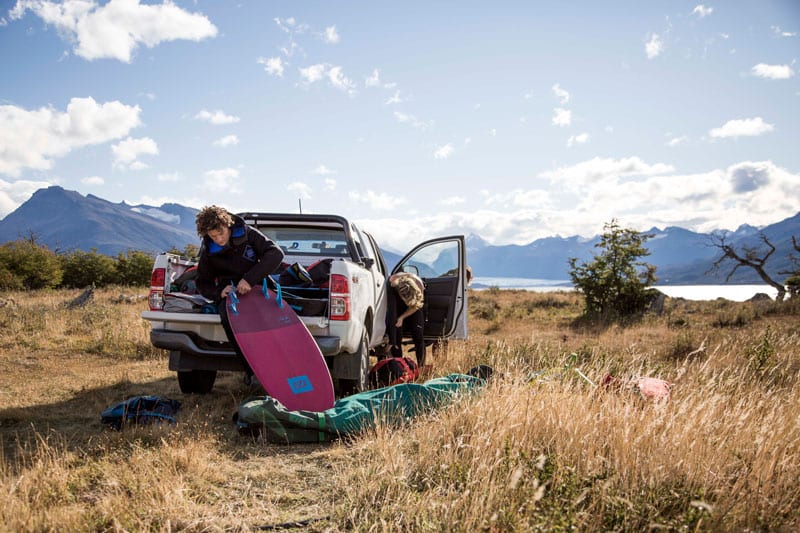
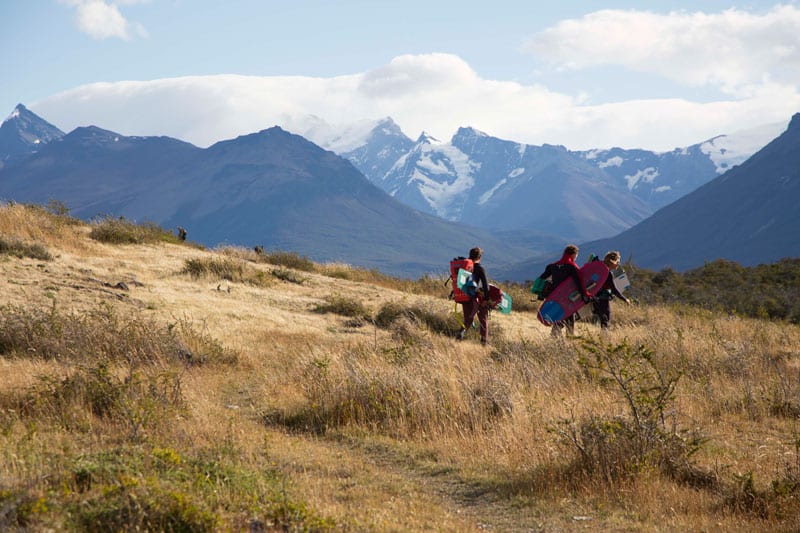
soon as we resigned ourselves to an empty-handed trek home a faint dark line appeared on the horizon. In mere minutes the wind filled in. We frantically launched our kites and soon Reno, Tom and I were on the water, blazing upwind in an all out rally to get as close as possible to the glacier.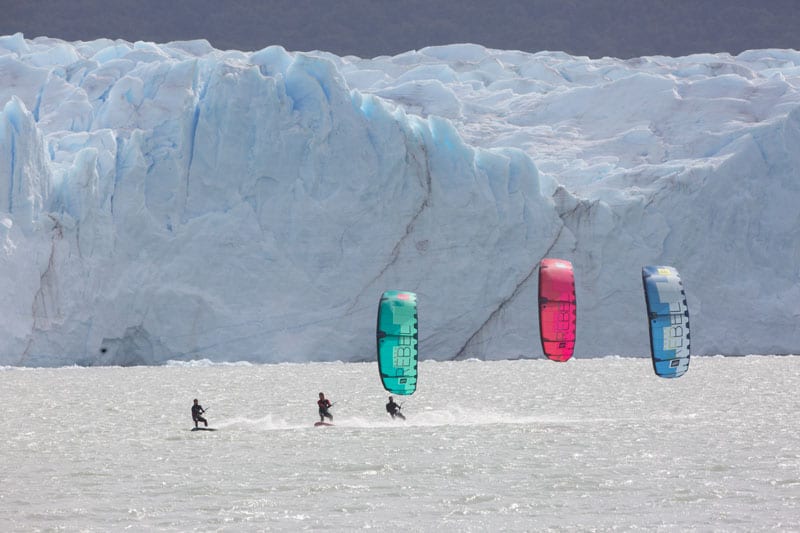
side of the kiteboarding experience. What we found was vast open wilderness and a place where the pure and untamed forces of nature are still alive and constantly on display. Perhaps the greatest discovery of our trip was a newfound appreciation of kiteboarding travel only for the sake of adventure.
